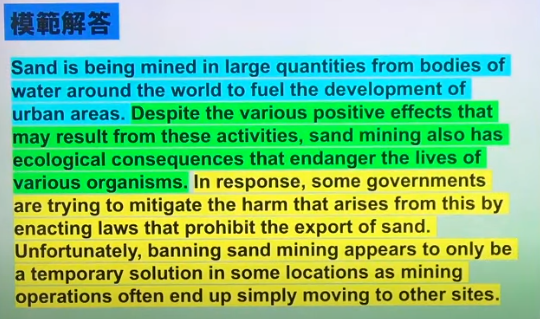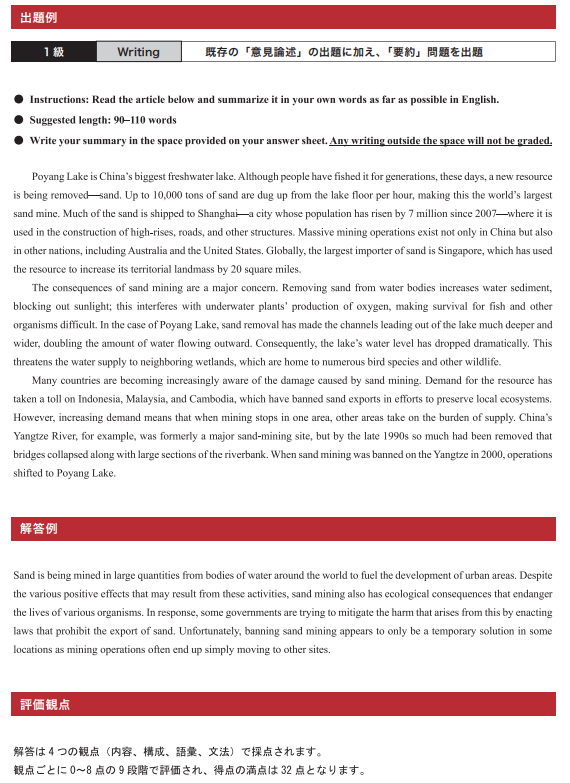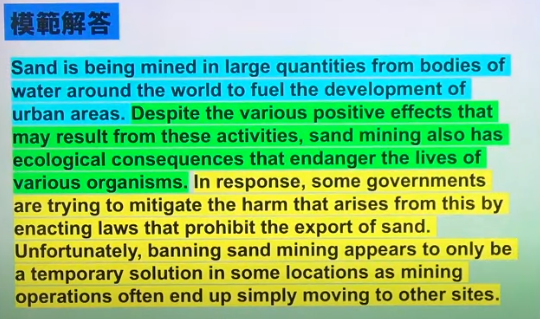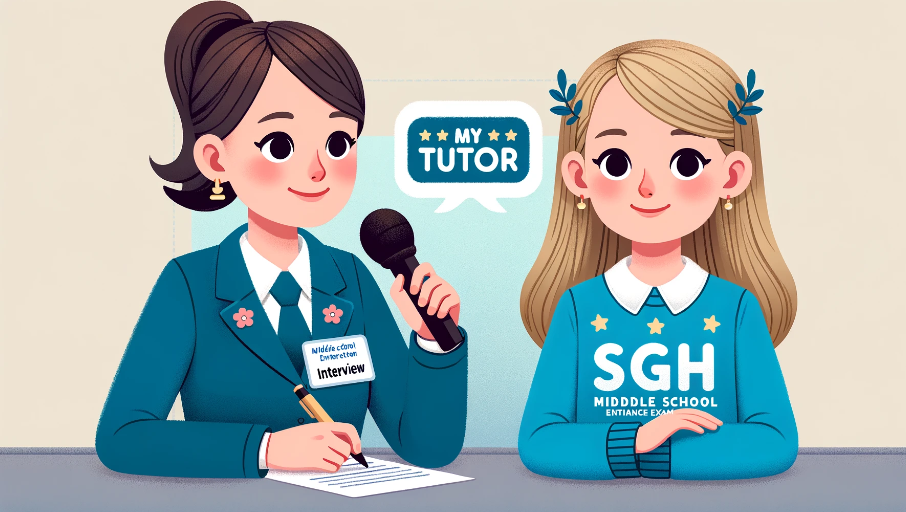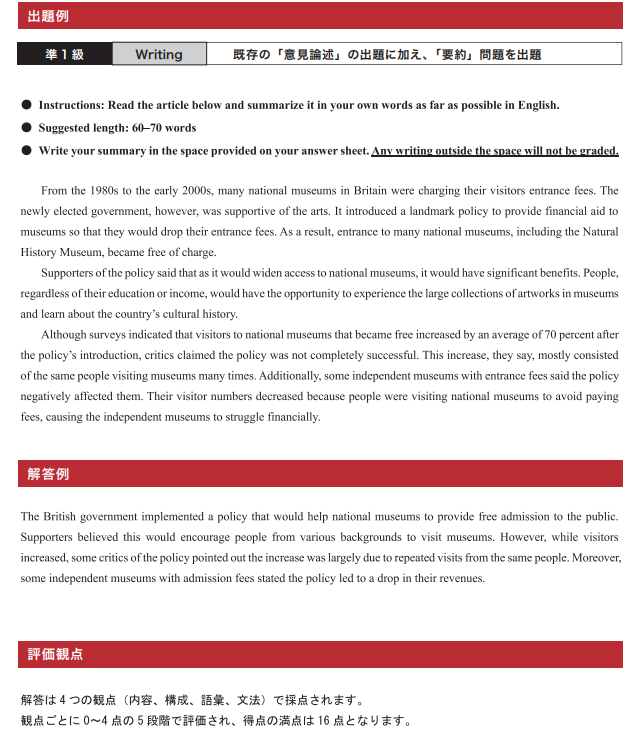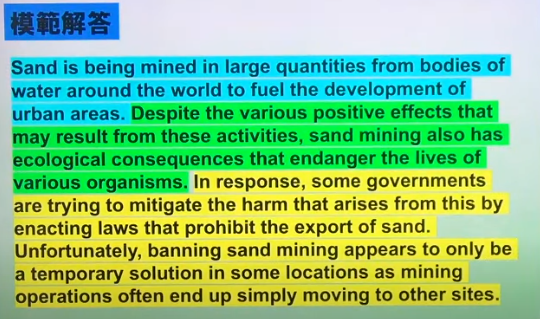▮ レッスンコース名: EIKEN Gade 1 Writing Summary Task
▮ レッスン数 : 50 レッスン―50 問 [ 標準:1問=1レッスン(25分)]
(受講者の判断で必要な分だけ受講してください。)
▮ 特徴 : オリジナル教材 試験類似問題を使います。
▮ レッスンの概要
予習型: 受講者は予習で解答文を作り、レッスン時間では、受講者の解答文を基に、講師が添削、アドバイスをしながら模範回答を作り上げていきます。
実践型: 本番同様、予習をせず講師の誘導で解答文を作り、添削、アドバイスを受けるながら模範解答を作り上げていきます。
※ 解答は4つの観点(内容、構成、語彙、文法)で添削されます。
━━ レッスンの進め方 ━━
① 事前に予習されることをお勧めします。解答文をwordなどのファイルで作っておきましょう。
(本番同様の緊張感でレッスンを進めたい方は、予習無しで進めてください。)
② 標準で1問を25分(1コマ)で完了となります。
③ レッスンでは、受講者が作った解答文を講師のチャットボックスに
ドロップして講師は添削します。
講師はパラグラフ毎に解答文を共有画面で受講者に見せながら添削していきます。
最後に完成文に対し、文章全体のアドバイスを致します。
④ レッスン中に完成できない場合、途中までの解答文を文書ファイル(word 又は
OpenOffice Writer)で受講者に渡します。
⑤ 受講者は次のレッスンまでに回答文を完成させ、レッスン時間に講師へ渡します。
⑥ 2 回目のレッスンでは共有画面で講師が完成文を添削していきます。 添削、アドバイ
ス、回答文の完成まで受講者のレベルに沿ったライティングレッスンとなります。
レッスン教材 一覧
● Instructions: Read the article below and summarize it in your own words as far as possible in English.
● Suggested length : 90–110 words
● Write your summary in the space provided on your answer sheet. Any writing outside the space will not be graded.
「 解答のコツ 」
以下の5つの要素に注して解答を使ってください。
①言葉を言い換える(そのまま抜き取って使わない)
②結論を変えない(自分の意見は入れない)
③例文、具体例は省く(メインのアイデアには関係がない)
④1段落で書く(もともと3段落以下の短い文章のため、1段落でまとめる必要がある)
⑤何よりも大事なのは、その文章の中で言いたいことが書かれているかです
Lesson 1 (181 words)
================================================
Lesson 2 (187 words )
======================================================
Lesson 3 (182 words )
=====================================================
Lesson 4 (230 words )
=========================================================
Lesson 5 (190 words )
============================================================
Lesson 6 (193 words )
=======================================================
Lesson 7 (188 words )
========================================================
Lesson 8 (202 words )
==========================================================
Lesson 9 (194 words )
=======================================================
Lesson 10 (197 words )
====================================================
Lesson 11 (181 words )
=======================================================
Lesson 12 (180 words )
====================================================
Lesson 13 (197 words )
=====================================================
Lesson 14 (212 words )
======================================================
Lesson 15 (203 words )
======================================================
Lesson 16 (193 words )
=========================================================
Lesson 17 (206 words )
==========================================================
Lesson 18 (188 words )
======================================================
Lesson 19 (205 words )
==================================================
Lesson 20 (197 words )
=========================================================
Lesson 21 (201 words )
=====================================================
Lesson 22 (185 words )
=====================================================
Lesson 23 (221 words )
=================================================
Lesson 24 (221 words )
======================================================
Lesson 25 (200 words)
==================================================
Lesson 26 (200 words)
================================================
Lesson 27 (200 words)
=======================================================
Lesson 28 (218 words )
======================================================
Lesson 29 (218 words )
===========================================================
Lesson 30 (197 words )
===========================================================
Lesson 31 (197 words )
=================================================
Lesson 32 (197 words )
===================================================
Lesson 33 (197 words )
========================================================
Lesson 34 (197 words )
==================================================
Lesson 35 (196 words )
===============================================
Lesson 36 (196 words )
=======================================================
Lesson 37 (196 words )
====================================================
Lesson 38 (194 words )
======================================================
Lesson 39 (185 words )
======================================================
Lesson 40 (185 words )
=====================================================
Lesson 41 (185 words )
====================================================
Lesson 42 (185 words )
================================================
Lesson 43 (185 words )
===================================================
Lesson 44 (185 words )
=================================================
Lesson 45 (185 words )
===========================================================
Lesson 46 (185 words )
===================================================
Lesson 47 (185 words )
=========================================================
Lesson 48 (185 words )
========================================================
Lesson 48 (185 words )
================================================
Lesson 48 (185 words )


